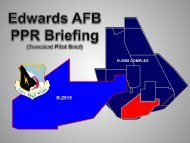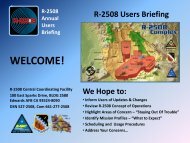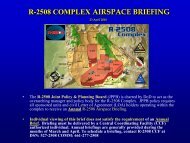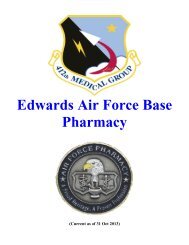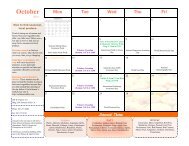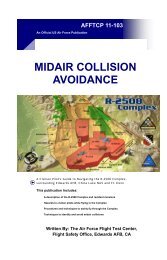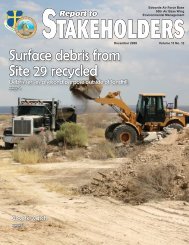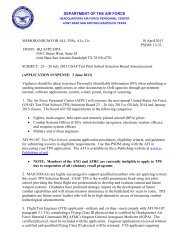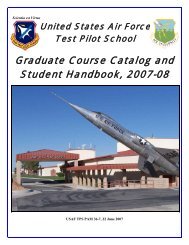AF Plant 42 AICUZ Study - Feb. 2012 - Edwards Air Force Base
AF Plant 42 AICUZ Study - Feb. 2012 - Edwards Air Force Base
AF Plant 42 AICUZ Study - Feb. 2012 - Edwards Air Force Base
You also want an ePaper? Increase the reach of your titles
YUMPU automatically turns print PDFs into web optimized ePapers that Google loves.
not developed. With respect to military and general aviation, nearby<br />
airfields include <strong>Edwards</strong> <strong>AF</strong>B (19 nautical miles [nm] northeast);<br />
Rosamond (15 nm north); General William Fox (9 nm northwest),<br />
and Aqua Dulce <strong>Air</strong>park (14 nm southwest).<br />
2.2 <strong>Plant</strong> <strong>42</strong> <strong>Air</strong>field Infrastructure<br />
The base has approximately 5,800 acres of property, with a runway<br />
complex consisting of two runways (4/22 and 7/25), parallel and<br />
intersecting taxiways, and several ramp areas for aircraft parking. The<br />
airfield elevation is 2,543 feet above mean sea level (MSL). Runway<br />
4/22 is 12,001 feet long by 150 feet wide and is oriented along a<br />
northeast-southwest axis; runway 7/25 is 12,002 feet long by 200 feet<br />
wide and is oriented along an east-west axis. Operations<br />
predominantly occur from east to west along Runway 25 although<br />
there is some seasonal variation when winds favor different runways.<br />
In addition to the intersecting runways, a portion of one of the parallel<br />
taxiways is designed to accommodate short field takeoffs and<br />
landings, simulating an assault strip for training purposes. Standard<br />
airfield lighting and ground based navigation transmitters associated<br />
with instrument landing systems allow approaches during periods of<br />
low cloud ceilings or visibility; additionally, a ground based<br />
transmitter for en route civil and military navigation (very high<br />
frequency omnirange, tactical air navigation [VORTAC]) providing<br />
distance and bearing to/from the station is located on the airfield.<br />
Finally, with the advent of global positioning system (GPS)<br />
technology, departure and approach procedures that do not rely upon<br />
terrestrial based transmitters have been developed and serve <strong>Plant</strong> <strong>42</strong>.<br />
Intersecting taxiways connect the runways to the aircraft parking<br />
areas, allowing for assigned aircraft to taxi to their respective ramps<br />
and hangers. Several tenant contractors (aircraft manufacturers) and<br />
the National Aeronautics and Space Administration (NASA) have<br />
significant hangar facilities and direct taxiway access; these<br />
corporations and agencies either own or lease facilities on or near the<br />
installation. <strong>Air</strong>craft maintenance and static engine runs occur at their<br />
respective parking areas, at the ends of the runways, or in test cells or<br />
hush houses located at some of the tenant facilities (Figure 2-2).<br />
The airfield at <strong>Plant</strong> <strong>42</strong> lies within controlled airspace, specifically the<br />
Class D airspace associated with the air traffic control (ATC)<br />
The term “National <strong>Air</strong>space<br />
System” (NAS) refers to a<br />
complex network of air<br />
navigation facilities, air traffic<br />
control facilities, airports,<br />
technology, and appropriate<br />
rules and regulations. <strong>Air</strong>craft<br />
operate within the NAS (and<br />
become subject to Federal<br />
Aviation Regulations) once they<br />
begin taxiing from their<br />
parking space with the intent to<br />
takeoff.<br />
2-4



